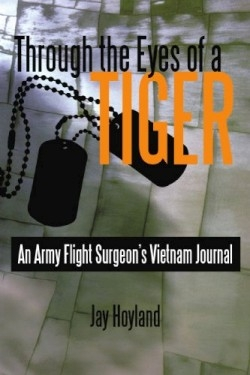It looks like you've stumbled upon a page meant to be read by our code instead of viewed directly. You're probably looking for this page.
Through the Eyes of a Tiger
An Army Flight Surgeon's Vietnam Journal
For forty years Jay Hoyland tried to forget those days in Vietnam that changed him so profoundly. But when an old soldier asked for his help with a bureaucratic problem, something made him unearth his diaries and letters and read the histories he’d avoided. Then he wrote this memoir. Through the Eyes of a Tiger is Hoyland’s fascinating account of his year as a flight surgeon in the early days of the Vietnam War.
Hoyland was drafted after completing his internship in August 1962 and receiving his medical degree from the University of Missouri. He trained for two months in Texas and Alabama to become a flight surgeon. On December 2 he landed in the Mekong Delta, to become the sole MD and commanding officer of the 134th Medical detachment, which served the “Soc Trang Tigers,” helicopter crews in constant danger.
Hoyland’s honesty is breathtaking. He didn’t want to be in the Army. He was afraid, as is everybody who faces combat duty, and even more afraid that he’d show that fear. He’d learned to aim a pistol, but doubted that he’d ever have the nerve to shoot anybody. He started counting the days until his year of duty would end.
Casualties came thick and fast. Hoyland made friends with the pilots and gunners he served, and saw some of them take off in the morning and never return. The Viet Cong eluded the Vietnamese Army with ease, and the fighting escalated. By February 1963, U.S. diplomats and generals still were telling John F. Kennedy that the war would be won easily, but Hoyland knew better. Speaking about the untrained local defense forces, who bore the brunt of the fighting but often went almost untreated, he writes:
Why didn’t they treat all wounded in combat at military hospitals? This country was at war. Many of their men…were being hurt, maimed, and killed. Something just wasn’t right.
But he became hardened as more things went wrong, and he knew he could shoot if necessary. Fighting bouts of mild depression, he kept saving lives and losing patients until his year was over. Meanwhile, he helped civilians, collecting funds from his officer friends to give presents to children locked up with their parents in the local leper colony and throwing parties for orphans in a nearby home.
The book includes excerpts from contemporary newspapers and magazines as well as reliable eye-witness histories, so it’s easy to foresee the disasters that would come as the fighting continued. Two pages of photographs show Hoyland at work and play.
Hoyland writes like a professional, and his tale compares well to anything that has been written about Vietnam. This is the kind of book that glues readers to its pages.
Disclosure: This article is not an endorsement, but a review. The publisher of this book provided free copies of the book and paid a small fee to have their book reviewed by a professional reviewer. Foreword Reviews and Clarion Reviews make no guarantee that the publisher will receive a positive review. Foreword Magazine, Inc. is disclosing this in accordance with the Federal Trade Commission’s 16 CFR, Part 255.
